Greater Flamingo
Posted: Tue May 22, 2012 10:11 am
096. Greater Flamingo Phoenicopterus roseus (Grootflamink)
Order: Phoenicopteriformes. Family: Phoenicopteridae
The Greater Flamingo was previously considered conspecific with the brighter coloured Caribbean flamingo, Phoenicopterus ruber, but the two are now considered separate species.
Description
127-140 cm. A large, long legged bird. The Greater Flamingo is mostly white with red only on its wings, white to pale pink plumage, contrasting red shoulders, and black tips to the wings. In flight, shows brilliant red patches in the forewings. Non-breading birds have whiter plumage. The legs are pink, the eyes yellow, and the beak is pale pink, with a black tip and a distinctive downward bend.
The female is smaller than the male.
The juvenile is grey-brown with paler underparts. The bill is pale bluish-grey with black tip. The eyes are dark. Legs and feet are grey.
Similar species: The Greater Flamingo often mixes with flocks of the Lesser Flamingo, but can be distinguished by its larger size, paler plumage, lighter beak, and pink rather than dark red legs. It differs from Lesser Flamingo in being paler pink, and in having a pink (not dark red) bill with a black tip. The Lesser Flamingo's deep-keeled bill filters minute blue-green algae and diatoms from the water, while the Greater Flamingo's shallow-keeled bill has coarser filters to strain small invertebrates.
Distribution
The most widespread flamingo species, the Greater Flamingo occurs across Africa, southern Europe, the Middle East, and into southern and southwestern Asia. In southern Africa, it is locally abundant along the coast of Mozambique, in southern Zimbabwe, central and southern Botswana, northern and western Namibia and central and south-western South Africa.
Habitat
Shallow freshwater lakes and pans.
Diet
It mainly eats small invertebrates, such as brine shrimps (Artemia), brine flies (Ephydra), molluscs and diatoms. In muddy flats or shallow water, they use their long legs and webbed feet to stir up the bottom. They then bury their bills, or even their entire heads, and suck up both mud and water to access the tasty morsels within. A flamingo's beak has a filter-like structure to remove food from the water before the liquid is expelled. Shrimplike crustaceans are responsible for the flamingo's pink color.
Breeding
Monogamous, although it changes its mate each breeding season, breeding in colonies with hundreds to thousands of nests. Hundreds of them perform a spectacular courtship display in which they march in the same direction while flapping their wings and outstretching their necks. The nest is built mainly by the male at first, while the female starts to assist him in the run up to the egg-laying season. It consists of a mound of dry or damp mud, with a shallow depression in the centre, about 15-45 cm high. It is often built on top of an older nest. Egg-laying season starts in November, peaking from January-February, although egg-laying may continue in waves until August. It lays a single chalky-white egg, rarely two, which is incubated by both sexes for roughly 27-31 days. The chicks are brooded for the first 3-4 days of their lives, leaving the nest at 5-10 days old to join a crèche along with other Lesser and Greater flamingos of similar age. It is fed by both parents with a glandular secretion, taking its first flight at about 75-80 days old. Young flamingos are born gray and white and do not turn pink for two years. In years when wetlands and pools are dry and food scarce, flamingoes may not breed.
Call
The call is a goose-like, honking ka-haunk. Listen to Bird Call.
Status
Locally abundant resident and visitor. Highly nomadic and partially migratory, usually in large flocks. Not threatened globally, although Near-threatened in South Africa and Vulnerable in Namibia, largely due to lowering water tables at major breeding sites and collision with power lines.
Order: Phoenicopteriformes. Family: Phoenicopteridae
The Greater Flamingo was previously considered conspecific with the brighter coloured Caribbean flamingo, Phoenicopterus ruber, but the two are now considered separate species.
Description
127-140 cm. A large, long legged bird. The Greater Flamingo is mostly white with red only on its wings, white to pale pink plumage, contrasting red shoulders, and black tips to the wings. In flight, shows brilliant red patches in the forewings. Non-breading birds have whiter plumage. The legs are pink, the eyes yellow, and the beak is pale pink, with a black tip and a distinctive downward bend.
The female is smaller than the male.
The juvenile is grey-brown with paler underparts. The bill is pale bluish-grey with black tip. The eyes are dark. Legs and feet are grey.
Similar species: The Greater Flamingo often mixes with flocks of the Lesser Flamingo, but can be distinguished by its larger size, paler plumage, lighter beak, and pink rather than dark red legs. It differs from Lesser Flamingo in being paler pink, and in having a pink (not dark red) bill with a black tip. The Lesser Flamingo's deep-keeled bill filters minute blue-green algae and diatoms from the water, while the Greater Flamingo's shallow-keeled bill has coarser filters to strain small invertebrates.
Distribution
The most widespread flamingo species, the Greater Flamingo occurs across Africa, southern Europe, the Middle East, and into southern and southwestern Asia. In southern Africa, it is locally abundant along the coast of Mozambique, in southern Zimbabwe, central and southern Botswana, northern and western Namibia and central and south-western South Africa.
Habitat
Shallow freshwater lakes and pans.
Diet
It mainly eats small invertebrates, such as brine shrimps (Artemia), brine flies (Ephydra), molluscs and diatoms. In muddy flats or shallow water, they use their long legs and webbed feet to stir up the bottom. They then bury their bills, or even their entire heads, and suck up both mud and water to access the tasty morsels within. A flamingo's beak has a filter-like structure to remove food from the water before the liquid is expelled. Shrimplike crustaceans are responsible for the flamingo's pink color.
Breeding
Monogamous, although it changes its mate each breeding season, breeding in colonies with hundreds to thousands of nests. Hundreds of them perform a spectacular courtship display in which they march in the same direction while flapping their wings and outstretching their necks. The nest is built mainly by the male at first, while the female starts to assist him in the run up to the egg-laying season. It consists of a mound of dry or damp mud, with a shallow depression in the centre, about 15-45 cm high. It is often built on top of an older nest. Egg-laying season starts in November, peaking from January-February, although egg-laying may continue in waves until August. It lays a single chalky-white egg, rarely two, which is incubated by both sexes for roughly 27-31 days. The chicks are brooded for the first 3-4 days of their lives, leaving the nest at 5-10 days old to join a crèche along with other Lesser and Greater flamingos of similar age. It is fed by both parents with a glandular secretion, taking its first flight at about 75-80 days old. Young flamingos are born gray and white and do not turn pink for two years. In years when wetlands and pools are dry and food scarce, flamingoes may not breed.
Call
The call is a goose-like, honking ka-haunk. Listen to Bird Call.
Status
Locally abundant resident and visitor. Highly nomadic and partially migratory, usually in large flocks. Not threatened globally, although Near-threatened in South Africa and Vulnerable in Namibia, largely due to lowering water tables at major breeding sites and collision with power lines.

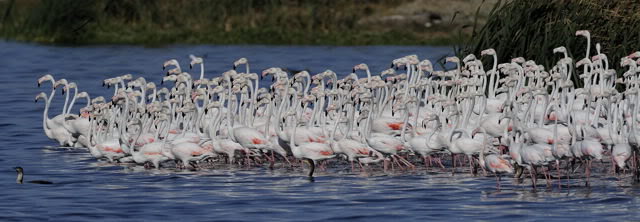

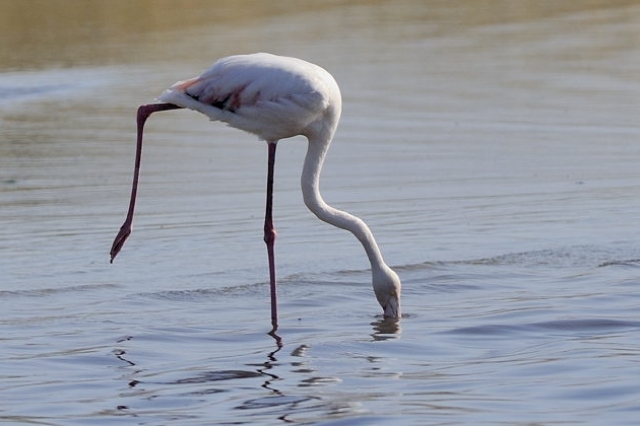
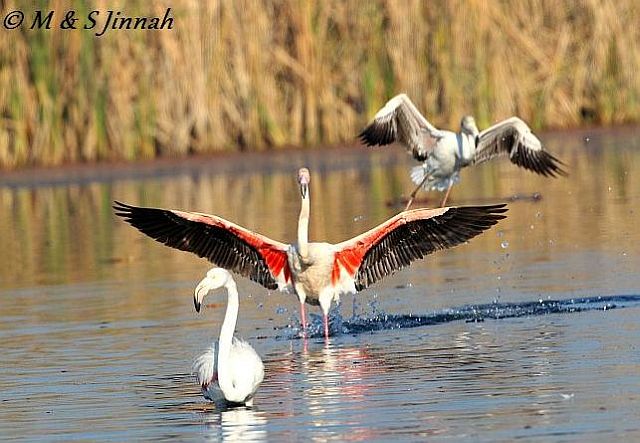 © Sharifa
© Sharifa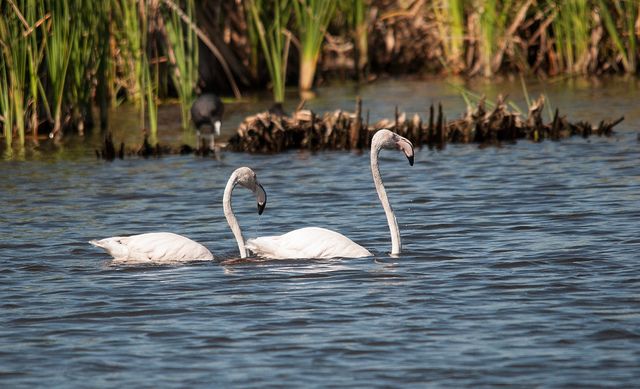 © steamtrainfan
© steamtrainfan © nan
© nan © PRWIN
© PRWIN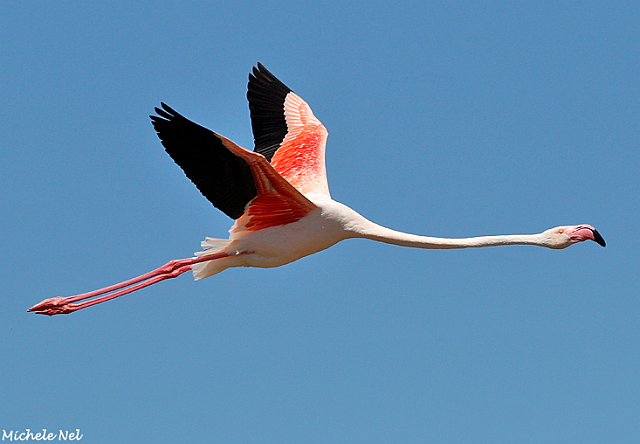 © Michele Nel
© Michele Nel © Dindingwe
© Dindingwe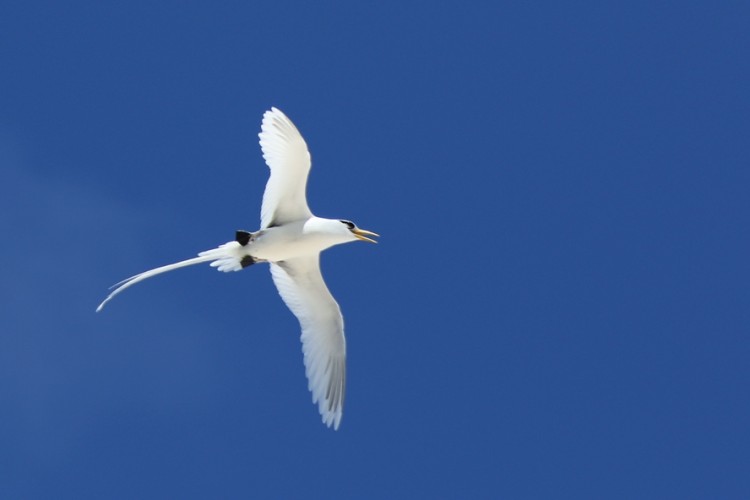 © Dindingwe
© Dindingwe © Dindingwe
© Dindingwe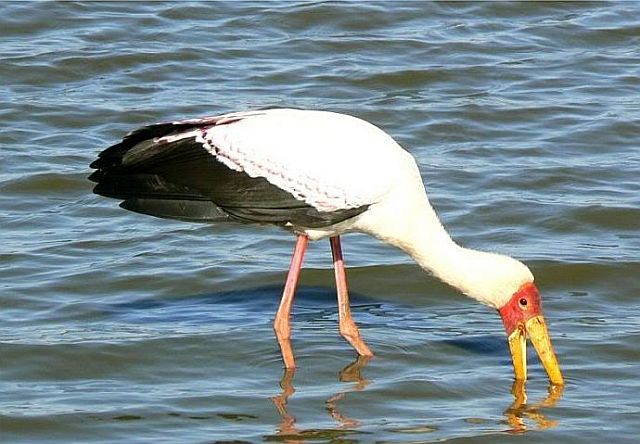 © Toko
© Toko © leachy
© leachy 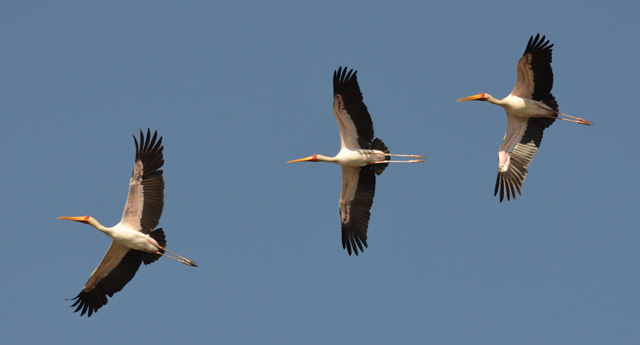 © BluTuna
© BluTuna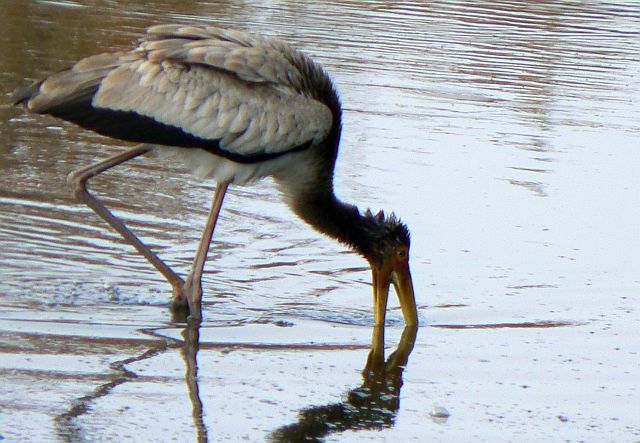 © Toko
© Toko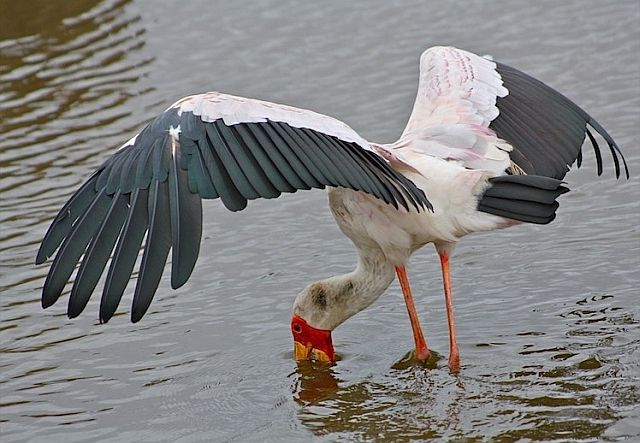 (Breeding Plumage) © ExFmem
(Breeding Plumage) © ExFmem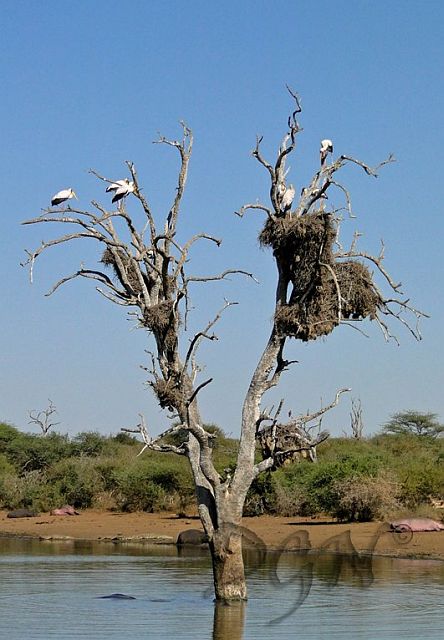 © JustN@ture
© JustN@ture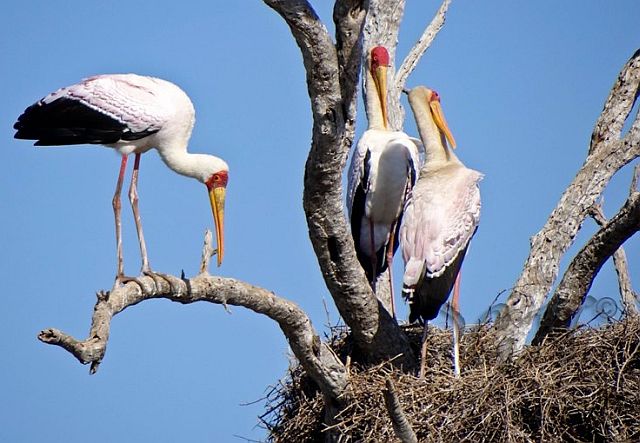 © JustN@ture
© JustN@ture